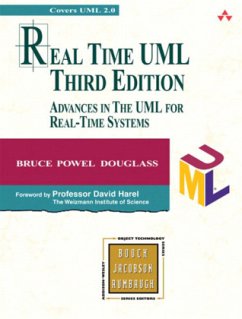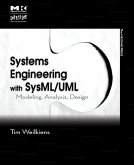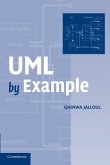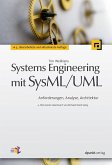Introduces embedded system practitioners to basic object technology concepts and the latest version of the industry-standard UML.
Fully revised and updated, current with UML 2.0.
The best instruction for applying traditional software methods to the intricacies of real-time programming.
Retains author's signature teaching style and incorporates feedback from the first two editions.
The two previous editions were written as easy-to-read introductions to the UML, and how to apply its notation and semantics to the unique requirements involved with the development of real-time and embedded systems. This third edition is no exception. Although the book's emphasis is on UML, it is also about capturing the requirements, structure, and behavior of real-time systems. The most significant change in this revision will be it's integration throughout the book of UML 2.0, and all indications are that UML 2.0 is even more accepting of the unique aspects of real-time and embedded systems development. Product Description
Praise for Real Time UML, Third Edition
"I found Real Time UML, Third Edition, to provide an informative and practical application of UML 2.0 to the development of real-time systems, and well worth the read by systems and software engineers. It is written in plain English and provides the right balance of depth and breadth."
-Sanford Friedenthal, Deputy, Corporate Systems Engineering, Lockheed Martin Corporation; Chair: OMG Systems Engineering, Domain Special Interest Group
"Douglass has again made highly technical material accessible to everyone. This book is an excellent introduction to the new UML 2.0, and if you want to learn what modeling for real-time environments is like, this is the book to read. His witty, conversational style should be a model for all authors of technical material."
-Gary K. Evans, Founder and Object Evangelist, Evanetics, Inc. (www.evanetics.com )
"Douglass has been a co-chair of the OMG's group interested in quality of service issues and, therefore, has valuable insights into the usefulness of these emerging technologies. His clear presentation of this information helps those applying these advanced technologies to extract the most benefit for their organizations and products, not only for the intended real-time embedded product, but also for products whose quality of performance, while not critical, is nevertheless of interest."
-Thérèse M. Smith, President and CEO, Air Traffic Software Architecture, Inc. (USA and Canada)
"The author presents an excellent overview of UML in the real-time space with plenty of colorful examples. This book is an excellent teaching tool for a newcomer or a reference for an expert!"
-Soma Chatterjee, Senior Product Manager, I-Logix
The increasing complexity of embedded and real-time systems requires a more premeditated and sophisticated design approach for successful implementation. The object-based Unified Modeling Language (UML) can describe the structural and behavioral aspects critical to real-time systems and has come to the fore as an outstanding medium for effective design.
Like its best-selling predecessors, Real Time UML, Third Edition, provides an overview of the essentials of real-time systems and an introduction to UML that focuses on the use of the ever-evolving standard in design and development. This accessible book examines requirements analysis, the definition of object structure and behavior, architectural and mechanistic design, and more detailed designs that encompass data structure, operations, and exceptions. Numerous figures help illustrate UML design techniques, and detailed, real-world examples show the application of those techniques to embedded systems.
This significantly revised edition features the new UML 2.0 standard, which dramatically improves the clarity of the UML for capturing architectures and improving its scalability. Real Time UML, Third Edition, also introduces the UML Profile for Schedulability, Performance, and Time (STP Profile). The STP Profile provides a standardized way to capture schedulability and performance constraints of systems. This allows analysis tools to read and analyze UML models.
Key topic coverage includes:
The Rapid Object-Oriented Process for Embedded Systems (ROPES)
Concurrency and resource modeling with the Real-Time (SPT) UML Profile
Tapping action semantics for greater executability
Scenario modeling with timing diagrams
Key strategies for object identification
Defining object state behavior
Representing and identifying threads
Mechanistic design patterns
Representing Command, Control, Communications, Computers, Intelligence, and Reconnaissance (C4ISR) Architectures with the UML
Backcover
Praise for Real Time UML, Third Edition
"I found Real Time UML, Third Edition to provide an informative and practical application of UML 2.0 to the development of real-time systems, and well worth the read by systems and software engineers. It is written in plain English and provides the right balance of depth and breadth."
-Sanford Friedenthal
Deputy, Corporate Systems Engineering,
Lockheed Martin Corporation
Chair: OMG Systems Engineering
Domain Special Interest Group
"Douglass has again made highly technical material accessible to everyone. This book is an excellent introduction to the new UML 2.0, and if you want to learn what modeling for real-time environments is like, this is the book to read. His witty, conversational style should be a model for all authors of technical material."
-Gary K. Evans
Founder and Object Evangelist,
Evanetics, Inc. (www.evanetics.com )
"Douglass has been a co-chair of the OMG's group interested in quality of service issues and, therefore, has valuable insights into the usefulness of these emerging technologies. His clear presentation of this information helps those applying these advanced technologies to extract the most benefit for their organizations and products, not only for the intended real-time embedded product, but also for products whose quality of performance, while not critical, is nevertheless of interest."
-Thérèse M. Smith
President and CEO,
Air Traffic Software Architecture, Inc.
(USA and Canada)
"The author presents an excellent overview of UML in the real-time space with plenty of colorful examples. This book is an excellent teaching tool for a newcomer or a reference for an expert!"
-Soma Chatterjee
Senior Product Manager,
I-Logix
The increasing complexity of embedded and real-time systems requires a more premeditated and sophisticated design approach for successful implementation. The object-based Unified Modeling Language (UML) can describe the structural and behavioral aspects critical to real-time systems and has come to the fore as an outstanding medium for effective design.
Like its best-selling predecessors, Real Time UML, Third Edition, provides an overview of the essentials of real-time systems and an introduction to UML that focuses on the use of the ever-evolving standard in design and development. This accessible book examines requirements analysis, the definition of object structure and behavior, architectural and mechanistic design, and more detailed designs that encompass data structure, operations, and exceptions. Numerous figures help illustrate UML design techniques, and detailed, real-world examples show the application of those techniques to embedded systems.
This significantly revised edition features the new UML 2.0 standard, which dramatically improves the clarity of the UML for capturing architectures and improving its scalability. Real Time UML, Third Edition, also introduces the UML Profile for Schedulability, Performance, and Time (STP Profile). The STP Profile provides a standardized way to capture schedulability and performance constraints of systems. This allows analysis tools to read and analyze UML models.
Key topic coverage includes:
The Rapid Object-Oriented Process for Embedded Systems (ROPES)
Concurrency and resource modeling with the Real-Time (SPT) UML Profile
Tapping action semantics for greater executability
Scenario modeling with timing diagrams
Key strategies for object identification
Defining object state behavior
Representing and identifying threads
Mechanistic design patterns
Representing Command, Control, Communications, Computers, Intelligence, and Reconnaissance (C4ISR) Architectures with the UML
Figure List.
About the Author.
Foreword to the Third Edition.
Foreword to the Previous Editions.
Preface to the Third Edition.
Preface to the Second Edition.
Preface to the First Edition.
Acknowledgments.
1. Introduction to the World of Real-Time and Embedded Systems.
What Is Special about Real-Time Systems?
Time, Performance, and Quality of Service.
Systems Engineering vs. Software Engineering.
What Do We Mean by Architecture?
The Rapid Object-Oriented Process for Embedded Systems (ROPES) Process.
MDA and Platform-Independent Models.
Scheduling Model-Based Projects.
Model Organization Principles.
Working with Model-Based Projects.
Looking Ahead.
Exercises.
References.
2. Object Orientation with UML 2.0-Structural Aspects.
Object Orientation with UML.
Small Things: Objects, Classes, and Interfaces.
Relations.
Big Things: Packages, Components, and Subsystems.
Advanced: UML Metamodel of Structural Elements (for the Advanced Modeler).
Additional Notations and Semantics.
Looking Ahead.
Exercises.
References.
3. Object Orientation with UML 2.0-Dynamic Aspects.
Behavior and the UML.
Types of Behavior.
Behavior Primitives: Actions and Activities.
Behavior and the Single Object.
Interactions.
Summary.
Exercises.
References.
4. UML Profile for Schedulability, Performance, and Time.
UML Profiles.
"RT UML" Profile.
Looking Ahead.
Exercises.
References.
5. Requirements Analysis of Real-Time Systems.
Requirements.
Use Cases.
Detailing the Use Cases.
Looking Ahead.
Exercises.
References.
6. Analysis: Object Domain Analysis.
The Object Discovery Process.
Connecting the Object Model with the Use Case Model.
Key Strategies for Object Identification.
Identify Object Associations.
Object Attributes.
Discovering Candidate Classes.
Class Diagrams.
Looking Ahead.
Exercises.
References.
7. Analysis: Defining Object Behavior.
Object Behavior.
Defining Object State Behavior.
Interactions.
Defining Operations.
Looking Ahead.
Exercises.
References.
8. Architectural Design.
Overview of Design.
What Is Architectural Design?
Software Meets Hardware: Deployment Architecture in UML.
Concurrency and Resource Design.
Looking Ahead.
Exercises.
References.
9. Mechanistic Design.
What Is Mechanistic Design?
Mechanistic Design Patterns.
The Observer Pattern.
The Proxy Pattern.
Reliable Transaction Pattern.
Smart Pointer Pattern.
Guarded Call Pattern.
Container Pattern.
The Rendezvous Pattern.
Looking Ahead.
Exercises.
References.
10. Detailed Design.
What Is Detailed Design?
Data Structure.
Associations.
Operations.
Visibility.
Algorithms.
Exceptions.
Summary.
Exercises.
References.
11. Special Topic: C4ISR Architecture and the UML.
Introduction.
What is C4ISR?
Required Products of C4ISR.
Supporting Products.
Summary.
Acknowledgments.
References.
Appendix: Notational Summary.
Index.
The two previous editions were written as easy-to-read introductions to the UML, and how to apply its notation and semantics to the unique requirements involved with the development of real-time and embedded systems. This third edition is no exception. Although the book's emphasis is on UML, it is also about capturing the requirements, structure, and behavior of real-time systems. The most significant change in this revision will be it's integration throughout the book of UML 2.0, and all indications are that UML 2.0 is even more accepting of the unique aspects of real-time and embedded systems development.
Fully revised and updated, current with UML 2.0.
The best instruction for applying traditional software methods to the intricacies of real-time programming.
Retains author's signature teaching style and incorporates feedback from the first two editions.
The two previous editions were written as easy-to-read introductions to the UML, and how to apply its notation and semantics to the unique requirements involved with the development of real-time and embedded systems. This third edition is no exception. Although the book's emphasis is on UML, it is also about capturing the requirements, structure, and behavior of real-time systems. The most significant change in this revision will be it's integration throughout the book of UML 2.0, and all indications are that UML 2.0 is even more accepting of the unique aspects of real-time and embedded systems development. Product Description
Praise for Real Time UML, Third Edition
"I found Real Time UML, Third Edition, to provide an informative and practical application of UML 2.0 to the development of real-time systems, and well worth the read by systems and software engineers. It is written in plain English and provides the right balance of depth and breadth."
-Sanford Friedenthal, Deputy, Corporate Systems Engineering, Lockheed Martin Corporation; Chair: OMG Systems Engineering, Domain Special Interest Group
"Douglass has again made highly technical material accessible to everyone. This book is an excellent introduction to the new UML 2.0, and if you want to learn what modeling for real-time environments is like, this is the book to read. His witty, conversational style should be a model for all authors of technical material."
-Gary K. Evans, Founder and Object Evangelist, Evanetics, Inc. (www.evanetics.com )
"Douglass has been a co-chair of the OMG's group interested in quality of service issues and, therefore, has valuable insights into the usefulness of these emerging technologies. His clear presentation of this information helps those applying these advanced technologies to extract the most benefit for their organizations and products, not only for the intended real-time embedded product, but also for products whose quality of performance, while not critical, is nevertheless of interest."
-Thérèse M. Smith, President and CEO, Air Traffic Software Architecture, Inc. (USA and Canada)
"The author presents an excellent overview of UML in the real-time space with plenty of colorful examples. This book is an excellent teaching tool for a newcomer or a reference for an expert!"
-Soma Chatterjee, Senior Product Manager, I-Logix
The increasing complexity of embedded and real-time systems requires a more premeditated and sophisticated design approach for successful implementation. The object-based Unified Modeling Language (UML) can describe the structural and behavioral aspects critical to real-time systems and has come to the fore as an outstanding medium for effective design.
Like its best-selling predecessors, Real Time UML, Third Edition, provides an overview of the essentials of real-time systems and an introduction to UML that focuses on the use of the ever-evolving standard in design and development. This accessible book examines requirements analysis, the definition of object structure and behavior, architectural and mechanistic design, and more detailed designs that encompass data structure, operations, and exceptions. Numerous figures help illustrate UML design techniques, and detailed, real-world examples show the application of those techniques to embedded systems.
This significantly revised edition features the new UML 2.0 standard, which dramatically improves the clarity of the UML for capturing architectures and improving its scalability. Real Time UML, Third Edition, also introduces the UML Profile for Schedulability, Performance, and Time (STP Profile). The STP Profile provides a standardized way to capture schedulability and performance constraints of systems. This allows analysis tools to read and analyze UML models.
Key topic coverage includes:
The Rapid Object-Oriented Process for Embedded Systems (ROPES)
Concurrency and resource modeling with the Real-Time (SPT) UML Profile
Tapping action semantics for greater executability
Scenario modeling with timing diagrams
Key strategies for object identification
Defining object state behavior
Representing and identifying threads
Mechanistic design patterns
Representing Command, Control, Communications, Computers, Intelligence, and Reconnaissance (C4ISR) Architectures with the UML
Backcover
Praise for Real Time UML, Third Edition
"I found Real Time UML, Third Edition to provide an informative and practical application of UML 2.0 to the development of real-time systems, and well worth the read by systems and software engineers. It is written in plain English and provides the right balance of depth and breadth."
-Sanford Friedenthal
Deputy, Corporate Systems Engineering,
Lockheed Martin Corporation
Chair: OMG Systems Engineering
Domain Special Interest Group
"Douglass has again made highly technical material accessible to everyone. This book is an excellent introduction to the new UML 2.0, and if you want to learn what modeling for real-time environments is like, this is the book to read. His witty, conversational style should be a model for all authors of technical material."
-Gary K. Evans
Founder and Object Evangelist,
Evanetics, Inc. (www.evanetics.com )
"Douglass has been a co-chair of the OMG's group interested in quality of service issues and, therefore, has valuable insights into the usefulness of these emerging technologies. His clear presentation of this information helps those applying these advanced technologies to extract the most benefit for their organizations and products, not only for the intended real-time embedded product, but also for products whose quality of performance, while not critical, is nevertheless of interest."
-Thérèse M. Smith
President and CEO,
Air Traffic Software Architecture, Inc.
(USA and Canada)
"The author presents an excellent overview of UML in the real-time space with plenty of colorful examples. This book is an excellent teaching tool for a newcomer or a reference for an expert!"
-Soma Chatterjee
Senior Product Manager,
I-Logix
The increasing complexity of embedded and real-time systems requires a more premeditated and sophisticated design approach for successful implementation. The object-based Unified Modeling Language (UML) can describe the structural and behavioral aspects critical to real-time systems and has come to the fore as an outstanding medium for effective design.
Like its best-selling predecessors, Real Time UML, Third Edition, provides an overview of the essentials of real-time systems and an introduction to UML that focuses on the use of the ever-evolving standard in design and development. This accessible book examines requirements analysis, the definition of object structure and behavior, architectural and mechanistic design, and more detailed designs that encompass data structure, operations, and exceptions. Numerous figures help illustrate UML design techniques, and detailed, real-world examples show the application of those techniques to embedded systems.
This significantly revised edition features the new UML 2.0 standard, which dramatically improves the clarity of the UML for capturing architectures and improving its scalability. Real Time UML, Third Edition, also introduces the UML Profile for Schedulability, Performance, and Time (STP Profile). The STP Profile provides a standardized way to capture schedulability and performance constraints of systems. This allows analysis tools to read and analyze UML models.
Key topic coverage includes:
The Rapid Object-Oriented Process for Embedded Systems (ROPES)
Concurrency and resource modeling with the Real-Time (SPT) UML Profile
Tapping action semantics for greater executability
Scenario modeling with timing diagrams
Key strategies for object identification
Defining object state behavior
Representing and identifying threads
Mechanistic design patterns
Representing Command, Control, Communications, Computers, Intelligence, and Reconnaissance (C4ISR) Architectures with the UML
Figure List.
About the Author.
Foreword to the Third Edition.
Foreword to the Previous Editions.
Preface to the Third Edition.
Preface to the Second Edition.
Preface to the First Edition.
Acknowledgments.
1. Introduction to the World of Real-Time and Embedded Systems.
What Is Special about Real-Time Systems?
Time, Performance, and Quality of Service.
Systems Engineering vs. Software Engineering.
What Do We Mean by Architecture?
The Rapid Object-Oriented Process for Embedded Systems (ROPES) Process.
MDA and Platform-Independent Models.
Scheduling Model-Based Projects.
Model Organization Principles.
Working with Model-Based Projects.
Looking Ahead.
Exercises.
References.
2. Object Orientation with UML 2.0-Structural Aspects.
Object Orientation with UML.
Small Things: Objects, Classes, and Interfaces.
Relations.
Big Things: Packages, Components, and Subsystems.
Advanced: UML Metamodel of Structural Elements (for the Advanced Modeler).
Additional Notations and Semantics.
Looking Ahead.
Exercises.
References.
3. Object Orientation with UML 2.0-Dynamic Aspects.
Behavior and the UML.
Types of Behavior.
Behavior Primitives: Actions and Activities.
Behavior and the Single Object.
Interactions.
Summary.
Exercises.
References.
4. UML Profile for Schedulability, Performance, and Time.
UML Profiles.
"RT UML" Profile.
Looking Ahead.
Exercises.
References.
5. Requirements Analysis of Real-Time Systems.
Requirements.
Use Cases.
Detailing the Use Cases.
Looking Ahead.
Exercises.
References.
6. Analysis: Object Domain Analysis.
The Object Discovery Process.
Connecting the Object Model with the Use Case Model.
Key Strategies for Object Identification.
Identify Object Associations.
Object Attributes.
Discovering Candidate Classes.
Class Diagrams.
Looking Ahead.
Exercises.
References.
7. Analysis: Defining Object Behavior.
Object Behavior.
Defining Object State Behavior.
Interactions.
Defining Operations.
Looking Ahead.
Exercises.
References.
8. Architectural Design.
Overview of Design.
What Is Architectural Design?
Software Meets Hardware: Deployment Architecture in UML.
Concurrency and Resource Design.
Looking Ahead.
Exercises.
References.
9. Mechanistic Design.
What Is Mechanistic Design?
Mechanistic Design Patterns.
The Observer Pattern.
The Proxy Pattern.
Reliable Transaction Pattern.
Smart Pointer Pattern.
Guarded Call Pattern.
Container Pattern.
The Rendezvous Pattern.
Looking Ahead.
Exercises.
References.
10. Detailed Design.
What Is Detailed Design?
Data Structure.
Associations.
Operations.
Visibility.
Algorithms.
Exceptions.
Summary.
Exercises.
References.
11. Special Topic: C4ISR Architecture and the UML.
Introduction.
What is C4ISR?
Required Products of C4ISR.
Supporting Products.
Summary.
Acknowledgments.
References.
Appendix: Notational Summary.
Index.
The two previous editions were written as easy-to-read introductions to the UML, and how to apply its notation and semantics to the unique requirements involved with the development of real-time and embedded systems. This third edition is no exception. Although the book's emphasis is on UML, it is also about capturing the requirements, structure, and behavior of real-time systems. The most significant change in this revision will be it's integration throughout the book of UML 2.0, and all indications are that UML 2.0 is even more accepting of the unique aspects of real-time and embedded systems development.





